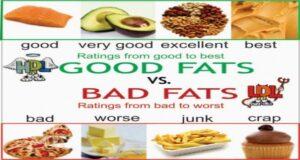Fats – are also organic compounds that serve many functions in the body. Most Body Fat is produced from carbohydrates, proteins, and fats consumed in the diet. Fat cells (adipocytes) are the storage cells for lipids (fats) that have been converted from excess carbohydrates and proteins.
As an energy reserve, adipose tissues store approximately 100,000 calories. Without additional nutrient intake, adipose storage can support metabolic functions for 30-40 days. Lipids have a very high caloric value (9 calories per gram) and serve as the body’s “back up generator” when carbohydrates (sugars) are in low supply for metabolic purposes.
 The number of “fat cells” in an adult remain constant throughout life after puberty (the exceptions being, excessive weight gain or liposuction will trigger adipocyte production). A “fat cell” is only 15 percent cell volume with 85 percent storage capacity for lipids (triglycerides). Adipose tissue is located throughout the body and serves as insulation and padding in addition to fuel reserves. Visceral fat is located within the body cavities and surrounds the organs. Subcutaneous fat is located under the skin and accumulates in specific areas such as the breasts and abdomen.
The number of “fat cells” in an adult remain constant throughout life after puberty (the exceptions being, excessive weight gain or liposuction will trigger adipocyte production). A “fat cell” is only 15 percent cell volume with 85 percent storage capacity for lipids (triglycerides). Adipose tissue is located throughout the body and serves as insulation and padding in addition to fuel reserves. Visceral fat is located within the body cavities and surrounds the organs. Subcutaneous fat is located under the skin and accumulates in specific areas such as the breasts and abdomen.
 Fats are not soluble in water and must be “emulsified” by enzymes and non-polar solvents in order to be absorbed into the blood. Cholesterols and triglycerides are the absorbed components of lipids and are composed of a glycerol base and 1 to 3 chains of fatty acids (monoglyceride, diglyceride, triglyceride). The fatty acid chains can be saturated (the bad fats, liquid at room temperature, contain maximum number of single hydrogen bonds) or unsaturated (the healthy fats, solid at room temperature, contain numerous double bonds with fewer hydrogen bonds).
Fats are not soluble in water and must be “emulsified” by enzymes and non-polar solvents in order to be absorbed into the blood. Cholesterols and triglycerides are the absorbed components of lipids and are composed of a glycerol base and 1 to 3 chains of fatty acids (monoglyceride, diglyceride, triglyceride). The fatty acid chains can be saturated (the bad fats, liquid at room temperature, contain maximum number of single hydrogen bonds) or unsaturated (the healthy fats, solid at room temperature, contain numerous double bonds with fewer hydrogen bonds).
 Metabolism of fats involve the breaking of the fatty acid chains from the glycerol body (lipolysis). These components are then converted into metabolic energy through the glycolysis pathway. Excess biproducts of lipolysis that is converted into Ketone bodies, which serves as an alternative energy source when glucose is unavailable (with diabetes, glucose cannot be transported into the cells to be metabolized, resulting in the body to utilize lipolysis to produce ketone bodies for fuel resulting in ketoacidosis).
Metabolism of fats involve the breaking of the fatty acid chains from the glycerol body (lipolysis). These components are then converted into metabolic energy through the glycolysis pathway. Excess biproducts of lipolysis that is converted into Ketone bodies, which serves as an alternative energy source when glucose is unavailable (with diabetes, glucose cannot be transported into the cells to be metabolized, resulting in the body to utilize lipolysis to produce ketone bodies for fuel resulting in ketoacidosis).
 When Glucose and Glycogen are not available, our body prefers the high caloric energy from fats as the next source of fuel. Fat takes more energy to break down but the energy released is enormous! (Fats are combustible and are used for fuel sources outside of the body as well).
When Glucose and Glycogen are not available, our body prefers the high caloric energy from fats as the next source of fuel. Fat takes more energy to break down but the energy released is enormous! (Fats are combustible and are used for fuel sources outside of the body as well).

